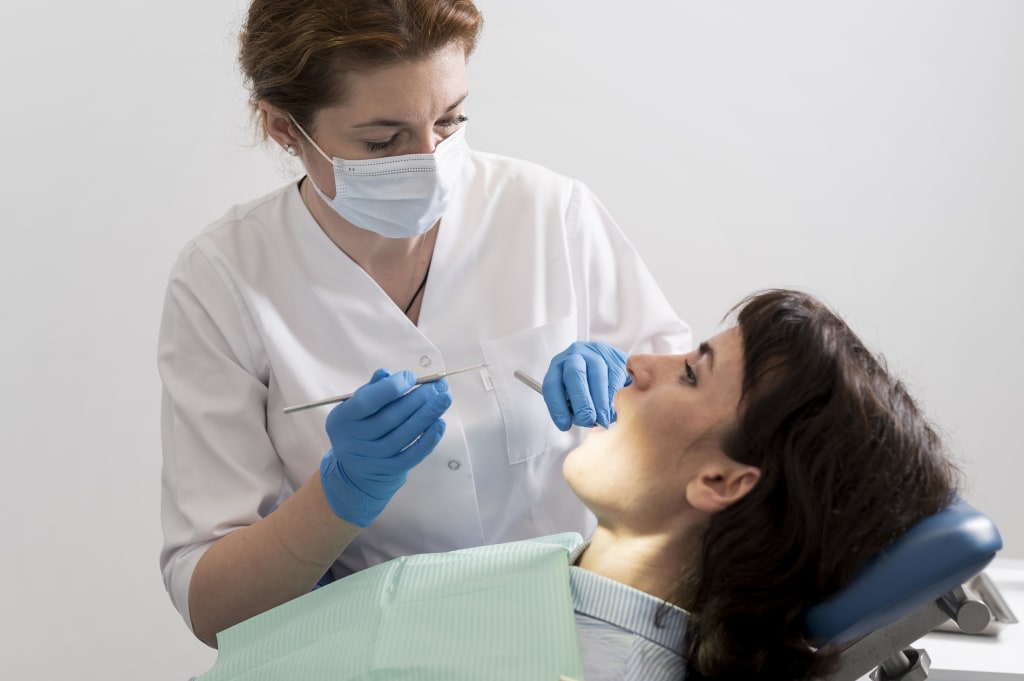The Advantages of Laser Dental Treatment: A Revolution in Oral Care
Laser dental treatment-benefits

In this article, we will explore the revolutionary advancements in dental treatment with the introduction of laser technology. Say goodbye to traditional methods involving drills and needles, as laser dental treatment brings a whole new level of precision and comfort to the dental chair.
Laser dental treatment offers a multitude of advantages, making it the preferred choice for many patients. With this innovative technique, dentists can easily target specific areas of the mouth, eliminating decay and bacteria without damaging surrounding healthy tissue. This results in less pain, reduced bleeding, and a quicker recovery time.
Furthermore, laser dental treatment is highly effective in treating gum disease, as it can eliminate infection and stimulate gum tissue regeneration. The precision of lasers also allows for precise reshaping of the gums, improving the overall appearance of your smile.
How laser dental treatment works
Laser dental treatment is a revolutionary technique that utilizes highly concentrated light energy to perform various dental procedures. Unlike traditional methods that rely on drills and scalpels, laser technology allows dentists to precisely target and remove diseased or damaged tissue without causing unnecessary harm to the surrounding healthy areas.
The basic principle behind laser dental treatment is the absorption of laser light by specific target tissues. Depending on the type of laser used, the light energy can be absorbed by water, pigments, or minerals present in the teeth and gums. This absorption of energy causes the target tissue to heat up, which in turn leads to the vaporization or removal of the unwanted material.
The versatility of laser dental treatment lies in the ability to fine-tune the laser's wavelength, power, and pulse duration to suit the specific needs of each patient and procedure. For example, a laser with a shorter wavelength may be used to remove tooth decay, while a longer wavelength may be more effective in treating gum disease by targeting the infected tissue. The precision of lasers also allows dentists to perform delicate procedures, such as the reshaping of gum tissue or the removal of oral lesions, with minimal disruption to the surrounding areas.
Advantages of laser dental treatment over traditional methods
One of the primary advantages of laser dental treatment is the reduced discomfort and pain experienced by patients during and after the procedure. Traditional dental methods often involve the use of drills and scalpels, which can cause significant discomfort and anxiety for many patients. In contrast, laser dental treatment is typically less invasive, as the laser energy can precisely target the affected area without the need for extensive cutting or drilling. This results in a more comfortable and relaxed experience for the patient, with reduced bleeding, swelling, and recovery time.
Another significant advantage of laser dental treatment is the improved precision and accuracy it offers. Lasers allow dentists to remove decayed or damaged tissue with remarkable precision, ensuring that only the necessary areas are treated and minimizing the risk of collateral damage to healthy teeth and gums. This precision translates to better outcomes, as the remaining healthy tissue is preserved, and the risk of complications, such as infection or further decay, is reduced.
Laser dental treatment also offers a more efficient and time-saving approach compared to traditional methods. The use of lasers can significantly reduce the duration of certain procedures, such as cavity removal and fillings, as the laser energy can quickly and effectively vaporize the diseased tissue. This efficiency not only benefits the patient but also helps to streamline the dental practice's workflow, allowing dentists to see more patients and provide a higher level of care.
Common dental issues that can be treated with lasers
Laser dental treatment is versatile and can be used to address a wide range of dental issues. One of the most common applications is the removal of tooth decay and the preparation of the tooth for fillings. Lasers can precisely target and remove decayed or damaged enamel and dentin without causing unnecessary harm to the surrounding healthy tissue. This results in a more conservative approach to cavity treatment, preserving more of the natural tooth structure.
Lasers are also highly effective in the treatment of gum disease, or periodontitis. By targeting the infected gum tissue, lasers can remove the buildup of plaque and tartar, eliminate harmful bacteria, and stimulate the regeneration of healthy gum tissue. This is particularly beneficial for patients with advanced gum disease, as laser treatment can help to halt the progression of the condition and improve the overall health of the gums.
Another common application of laser dental treatment is the reshaping of gum tissue, known as gingival contouring or gingivectomy. This procedure is often used to address issues such as gummy smiles, uneven gum lines, or the exposure of tooth roots due to gum recession. Lasers allow for precise and minimally invasive gum reshaping, resulting in a more aesthetically pleasing and healthy smile.
Lasers can also be used to remove oral lesions, such as canker sores, benign tumors, or pre-cancerous growths. The precision of laser technology allows for the targeted removal of these lesions without causing significant damage to the surrounding healthy tissue, reducing the risk of complications and promoting faster healing.
Safety and effectiveness of laser dental treatment
One of the primary concerns that patients may have about laser dental treatment is the safety and effectiveness of the procedure. However, laser dental technology has undergone extensive research and development, and it has been proven to be a safe and highly effective alternative to traditional dental methods.
The safety of laser dental treatment is largely due to the precise control and targeting capabilities of the laser. Dentists are trained to use the laser at specific wavelengths, power levels, and pulse durations to ensure that the energy is directed only at the intended target tissue. This minimizes the risk of collateral damage to surrounding healthy tissues, reducing the likelihood of complications such as burns, nerve damage, or excessive bleeding.
Numerous studies have demonstrated the effectiveness of laser dental treatment in addressing a wide range of dental issues. For example, research has shown that laser-assisted cavity removal and tooth preparation result in better-quality fillings and a lower risk of post-operative sensitivity compared to traditional drilling methods. Similarly, studies have proven the efficacy of laser treatment in the management of gum disease, with patients experiencing improved gum health and reduced risk of tooth loss.
Additionally, the use of lasers in dental procedures has been associated with faster healing times and reduced post-operative discomfort. This is due to the minimally invasive nature of laser treatment, which causes less trauma to the surrounding tissues and promotes a more rapid recovery process.
Cost and accessibility of laser dental treatment
One of the concerns that patients may have about laser dental treatment is the potential for higher costs compared to traditional methods. While it is true that the initial investment in laser technology can be significant for dental practices, the benefits of this advanced treatment often outweigh the additional costs.
In the long run, laser dental treatment can actually lead to cost savings for both the patient and the dental practice. The precision and efficiency of laser technology can result in fewer repeat visits, reduced need for anesthesia, and a lower risk of complications, all of which can translate to lower overall treatment costs. Additionally, the improved patient comfort and satisfaction associated with laser dental treatment can lead to better patient retention and referrals, ultimately benefiting the dental practice's bottom line.
As laser dental technology continues to advance and become more widespread, the accessibility of this innovative treatment is also improving. Many dental practices are now investing in laser equipment, recognizing the benefits it offers to their patients and their practice. Furthermore, some dental insurance providers are starting to cover the costs of laser dental treatment, making it more affordable for patients.
It is important to note that the cost of laser dental treatment can vary depending on the specific procedure, the dentist's experience and location, and the patient's individual dental needs. However, as the technology becomes more widely adopted, the costs are expected to continue to decrease, making laser dental treatment a more accessible option for a broader range of patients.
Laser dental treatment for children and adults
Laser dental treatment is not only beneficial for adult patients but can also be highly advantageous for children. The reduced discomfort and pain associated with laser procedures can make the dental experience much more comfortable and less anxiety-inducing for young patients.
Children, who may be particularly sensitive to the sounds and sensations of traditional dental tools, often respond better to the gentle and precise nature of laser technology. The reduced need for anesthesia and the faster healing time can also make the overall dental visit more pleasant and less disruptive to the child's daily routine.
Furthermore, the versatility of laser dental treatment allows dentists to address a wide range of pediatric dental issues, from cavity removal and fillings to the treatment of gum disease and the reshaping of gum tissue. This comprehensive approach to children's oral health can help to establish good dental habits and prevent the development of more serious problems in the future.
Adult patients can also benefit greatly from laser dental treatment, particularly those who have had negative experiences with traditional dental methods in the past. The reduced discomfort and anxiety associated with laser procedures can make even the most apprehensive patients more willing to seek regular dental care, improving their overall oral health and well-being.
Finding a dentist who offers laser dental treatment
As laser dental technology continues to gain popularity, more and more dentists are incorporating this innovative approach into their practices. However, it is essential for patients to do their research and find a dentist who is highly experienced and skilled in the use of laser technology.
When searching for a dentist who offers laser dental treatment, it is also important to consider their level of experience and the types of procedures they perform using laser technology. Patients should look for dentists who have been using lasers for several years and who can provide a comprehensive range of laser-based treatments, from cavity removal to gum disease management and cosmetic procedures.
Additionally, patients should feel comfortable communicating with their dentist about their concerns and expectations regarding laser dental treatment. A good dentist will take the time to explain the process, answer any questions, and ensure that the patient is fully informed and comfortable with the proposed treatment plan.
The introduction of laser dental treatment has truly revolutionized the field of oral care, offering patients a more comfortable, precise, and effective way to maintain their dental health. By harnessing the power of light energy, dentists can now target and address a wide range of dental issues with remarkable accuracy, minimizing the discomfort and complications associated with traditional methods.
From the treatment of tooth decay and gum disease to the reshaping of gum tissue and the removal of oral lesions, laser dental technology has proven to be a game-changer in the world of dentistry. With its numerous advantages, including reduced pain and recovery time, improved precision, and enhanced efficiency, it is no wonder that this innovative approach is quickly becoming the preferred choice for patients and dental professionals alike.
As the accessibility and affordability of laser dental treatment continue to improve, it is clear that this revolutionary technology is here to stay. By embracing the future of oral care and adopting this cutting-edge solution, patients can look forward to a more comfortable and effective dental experience, ultimately leading to better overall oral health and a brighter, more confident smile.
So, whether you are a seasoned dental patient or someone who has been hesitant to visit the dentist in the past, the time has come to explore the remarkable benefits of laser dental treatment. Embark on this exciting journey towards a healthier, happier smile and experience the future of oral care today.
About the Creator
Nivin Abraham
Writer, Blogger
Enjoyed the story? Support the Creator.
Subscribe for free to receive all their stories in your feed.






Comments
Nivin Abraham is not accepting comments at the moment
Want to show your support? Send them a one-off tip.